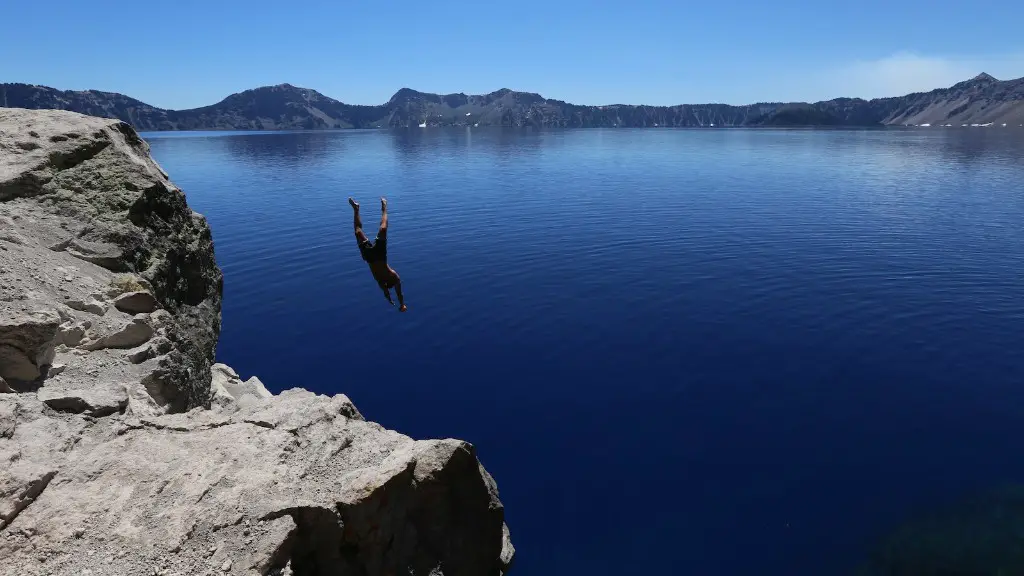Can You Scuba Dive In Lake Michigan
Lake Michigan is one of the five Great Lakes in North America, and is the second largest of the five. Spanning across four US states of Illinois, Indiana, Michigan and Wisconsin, Lake Michigan provides a fantastic scuba diving opportunity – but only if you do it in the right way.
Given the freshwater nature of Lake Michigan, the conditions for scuba diving are a bit different to what you may be used to in the ocean. But don’t worry – that doesn’t mean it’s impossible! With the right safety measures, preparation and techniques in place, scuba diving in Lake Michigan is a great way to explore the stunning underwater environment and all its marine life.
One of the main differences you need to take into account when planning a scuba dive in Lake Michigan is the fact that the visibility is usually poorer than in the ocean. This means that divers need to have more awareness and caution when exploring, so as to avoid any collisions with underwater obstacles such as rocks and obstacles.
Given such differences to ocean diving, here are a few important tips for scuba diving in Lake Michigan:
- Be sure to plan your dive meticulously and be well aware of the conditions before you dive.
- Make sure you wear appropriate clothing for your dive, such as a thick wetsuit and scuba booties, given the colder temperatures of the lake’s water.
- Be aware of the underwater currents, which can be strong, and plan your dive accordingly.
- Be sure to bring a friend diving – not only for safety reasons, but so you can make the most out of the dive with a buddy.
Despite clearer conditions underwater in the ocean, many scuba divers prefer fresh water scuba diving due to the variety of marine and plant life that can be found in Lake Michigan. Some of the incredible creatures you may witness and explore include lake trout, lake sturgeon, lake whitefish and more – in fact, Lake Michigan is home to over 120 species of fish!
Of course, when scuba diving in Lake Michigan, safety measures and respect for the environment must always be adhered to. Dive at the right depths, control your buoyancy and sampling strictly prohibited, and you are sure to experience a thrilling underwater adventure!
Safety First
Safety should always be the top priority when scuba diving. As such, ensuring you have the right training, safety equipment, and respect for the environment is essential.
In terms of training and safety equipment, investing in a dry suit and a dive computer is important for divers exploring the depths of Lake Michigan.
Want to make sure you pass your PADI diving qualifications? It’s a good idea to join a PADI Dive Master course or even a Dive Instructor course, so that you can gain further knowledge and better understand how to dive safely. Not only will this help you understand the necessary safety measures, but it will also give you the skills and knowledge to help and advise others when diving.
The cold water during the winter months can be a challenge for some, but an experienced dry suit diver will be more than comfortable exploring what Lake Michigan has to offer.
Of course, any diver should always make sure they have the right emergency contact information and emergency communication devices on board the boat before setting out, so that they can contact the right authorities in case of an emergency.
Explore The Shores
Lake Michigan also offers fascinating exploration opportunities above the waterline, too. So, it’s often worth planning a dive combined with some shore exploration, so that you can have both a viewed-filled and an adventurous experience.
In particular, the beaches on the Lake Michigan shore are great for some after-dive exploration. There are countless beaches along the horizon, with some of the most spectacular being in Illinois, such as the Illinois Beach State Park, Indiana Dunes State Park and Indiana Dunes National Lakeshore.
These beaches offer breathtaking views as well as wildlife spotting opportunities – be sure to keep an eye out for the wide variety of birds and mammals that call the Lake Michigan shores home.
Moreover, there are also many lighthouses and even navy vessels around the Great Lakes which make fantastic diving experiences – just remember to stick to the right depths and always follow the regulations and safety measures.
The Fauna & Flora
Scuba diving in Lake Michigan is a great way to explore life beyond the shore. As previously mentioned, there are over 120 species of fish in the lake, as well as a variety of plants and marine life.
The submerged terrestrial forest is especially enchanting – here, you can dive amongst fossil beds and fields of quaking aspen trees, as well as rare plants and animals.
When exploring the submerged forests, be sure to keep an eye out for the small jellyfish which are drawn to the lights of scuba divers. Pay attention to the interesting moss and rocks, too – these often play host to many small creatures such as crawfish and turtles.
Longitudinal Changes
It’s also worth noting that Lake Michigan has long been studied for its longitudinal changes – or water pull from all the rivers that empty into it. In recent years, government regulations and public education have contributed to the lake’s health and managed to keep much of the pollution absent.
But of course, pollution still persists, and divers need to be aware of the regulations which are set in place to protect it. For example, barring your dive light when diving so as to not hurt any of the marine life, and avoiding any contact with the various rumble strips which are in place to help preserve the underwater ecosystem.
Ultimately, this means that you must plan your dive with care, making sure you stick to the designated scuba diving paths and follow the rules on a detailed dive plan.
The Local Environment
If you want your Lake Michigan dive to go as smoothly as possible, it’s also important to understand the local environment. There are many no-fishing zones and protected areas around the lake shore, as set by local government, so as to help restore and conserve the lake’s aquatic life.
Therefore, it’s important to pay attention to each state’s local regulations, so as to stay safe and avoid any harm to the environment. Moreover, it’s important to respect the fishermen and the other recreational activities taking place on the lake.
Moreover, be sure to interact with the local dive community and sign up for regular dive classes and safety courses. An understanding of the local environment and a respect for the regulations and safety measures in Lake Michigan will go a long way in helping you enjoy a fantastic and safe scuba diving experience.
Weather Considerations
When planning a dive in Lake Michigan, it’s important to note that the weather can change very quickly, and storms often come up as a surprise. Before dive, pay attention to the forecasts and decide when the weather is going to be good enough to dive.
Every diver needs to have a safety plan and be aware of the risks associated with the lake they are diving in. Think about the “what ifs” – the “what if” the weather suddenly changes? What if an unexpected storm occurs? The key is to be well prepared and have an answer to these types of questions.
In addition, bear in mind that any plastic or metal objects, such as tackle boxes or cameras, may need to be left on shore due to the lake’s colder temperatures. Moreover, it’s worth being aware of the potential risks that come from diving in strong currents and murky waters.
Lake Michigan Dive Certification
If you plan on scuba diving in Lake Michigan, it’s important to get properly certified first. You may already be an experienced diver, but diving in freshwater is still much different than being in the ocean, so you’ll need to take a special course.
In terms of certifications, many dive organizations offer courses specifically designed for Lake Michigan. Before signing up for one of these courses, make sure you have a grasp of the basics such as dive safety, and passing knowledge on basic dive equipment and techniques.
Join a course in Lake Michigan, and you will learn the essential information required to safely and efficiently explore the depths of the lake. Moreover, it’s a great way to pick up priceless tips and information from an experienced instructor, who can help you make the most out of your Lake Michigan scuba diving experience.
Picking The Right Equipment Choices
Finally, picking the right equipment for diving in Lake Michigan is absolutely essential. Given the coldness of the waters, a thick wetsuit is certainly a must, as well as gloves, a hood, and a dive computer to accurately measure your progress.
In addition, it’s important to pick a reliable regulator and buoyancy compensator, given the strong currents that can be found in the lake. And don’t forget a flashlight, which will help light your way in the darker parts of the lake.
Overall, if you’re willing to prepare yourself and understand the local conditions, scuba diving in Lake Michigan is a fantastic and awe-inspiring experience. With its stunning marine life and diversity of flora and fauna, makes it one of the most popular locations for divers and adventurers alike.





